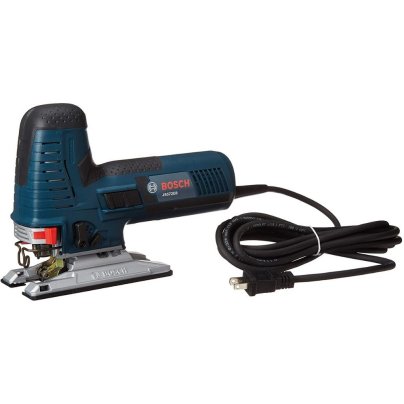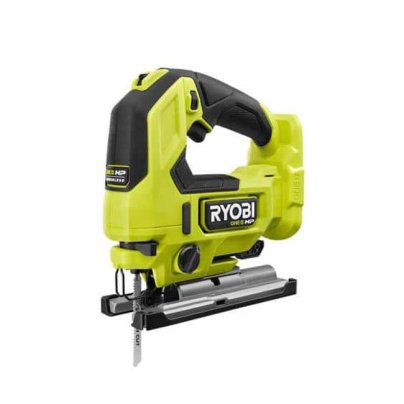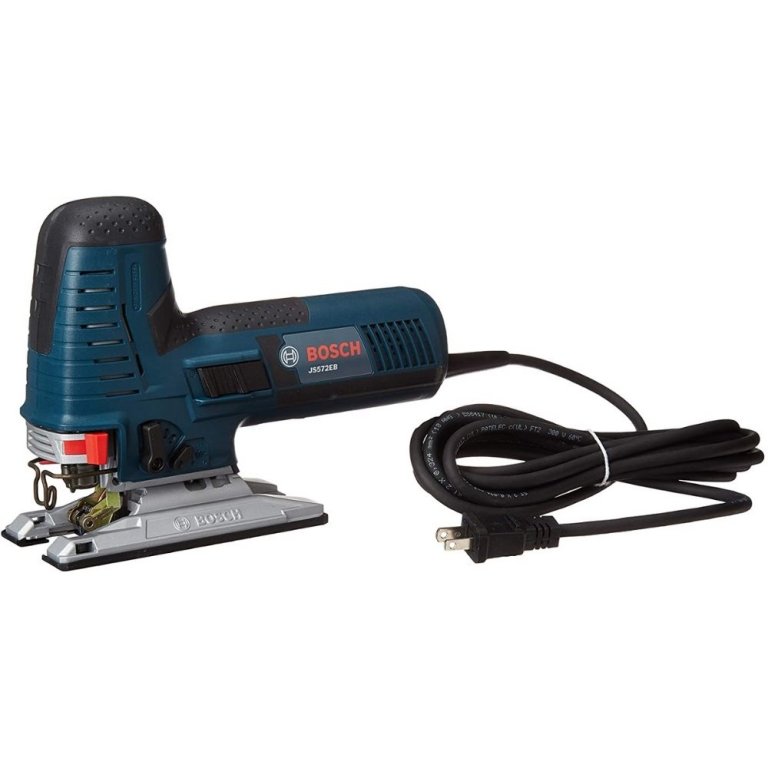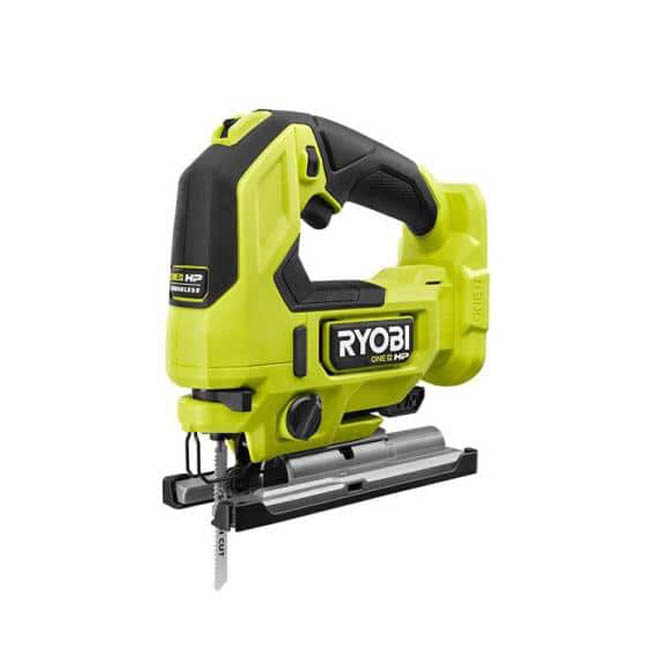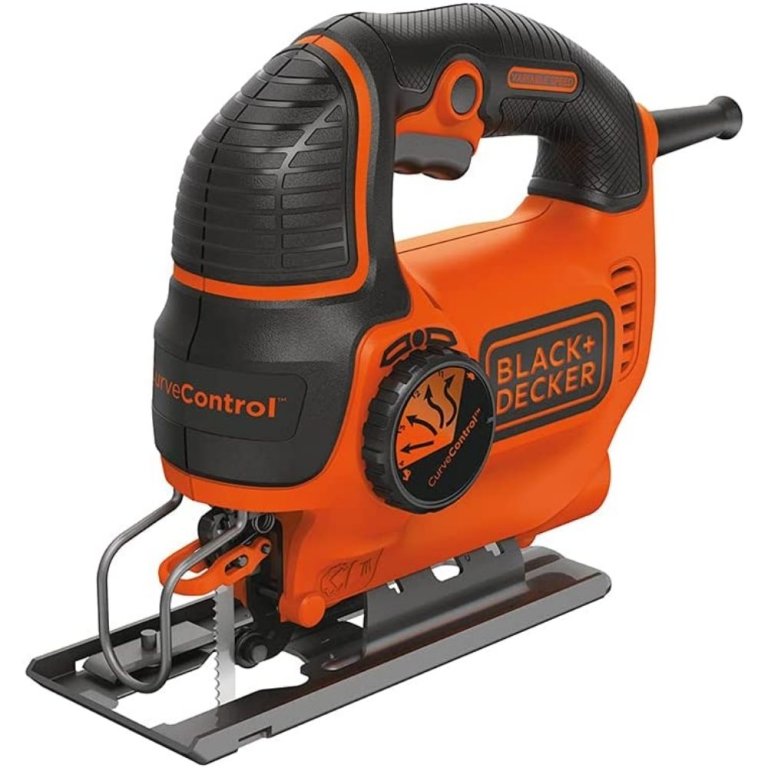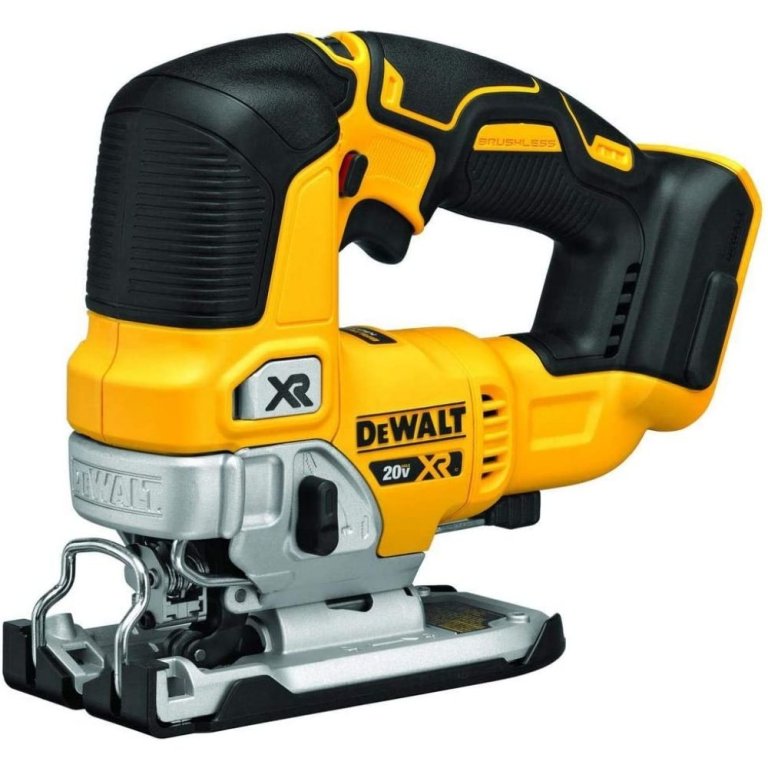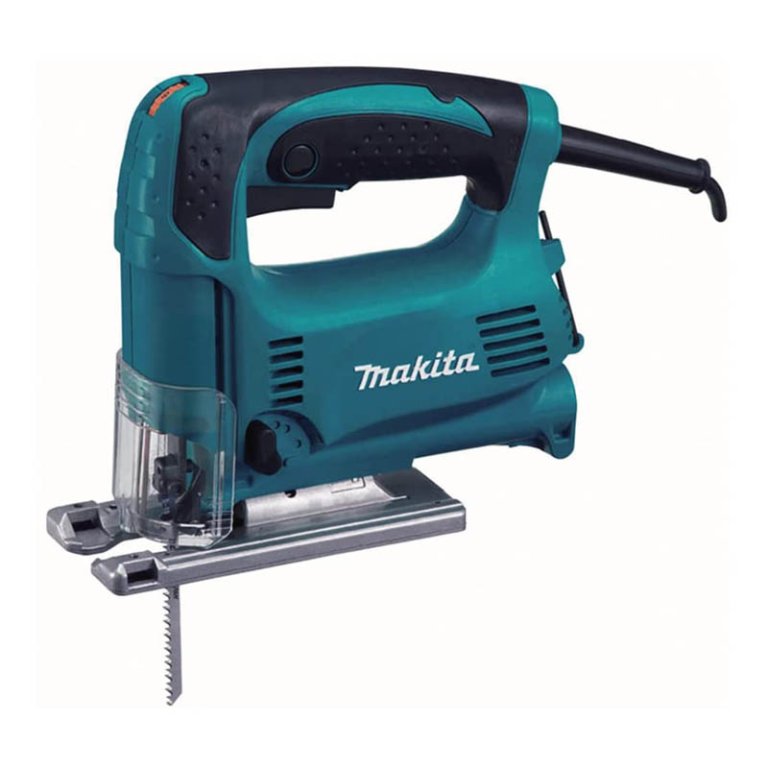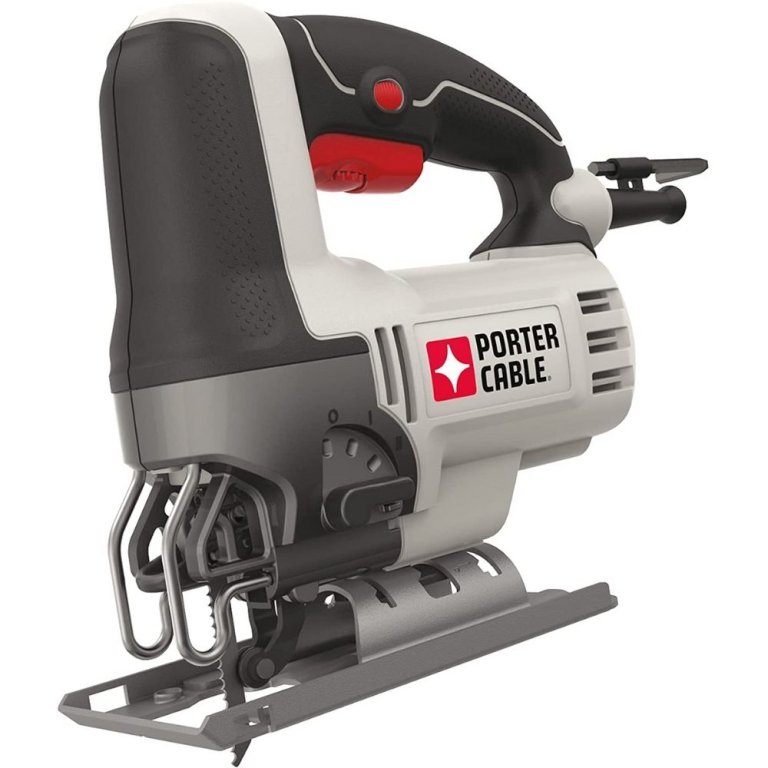
We may earn revenue from the products available on this page and participate in affiliate programs. Learn More ›
As an electric saw with a vertically plunging blade, the jigsaw tends to be underappreciated. True, it’s not as powerful or fast as a circular saw, and it can be a little tricky to master. Still, savvy carpenters, woodworkers, metalworkers, and even DIYers know to reach for one of these capable tools to make various cutting tasks a breeze.
The jigsaw’s main purpose is to cut curves, but it can also cut lumber to length with ease and create holes and other shapes in materials such as plywood and plastic. Today’s models are lighter, more powerful, and more versatile than ever.
This guide will help in choosing the best jigsaw for your DIY or professional projects. We put some of the most popular brands to the test, evaluating both corded and cordless saws. Cutting through ½-inch thick plywood, we evaluated their features, how smoothly they cut, and how aggressively they could blitz through wood.
- BEST OVERALL: Bosch JS572EBK Barrel-Grip Jigsaw Kit
- BEST BANG FOR THE BUCK: Ryobi 18V One+ HP Brushless Jigsaw
- BEST FOR BEGINNERS: Black+Decker 5-Amp Jigsaw with Curve Control
- BEST FOR MAX POWER: Milwaukee M18 Fuel Barrel Grip Jigsaw
- BEST ERGONOMIC HANDLE: DeWalt 20V MAX XR Cordless Jigsaw
- BEST LIGHTWEIGHT SAW: Makita 4329K Top Handle Jig Saw
- BEST FOR FAST CUTTING: Porter-Cable 6-Amp Orbital Jigsaw
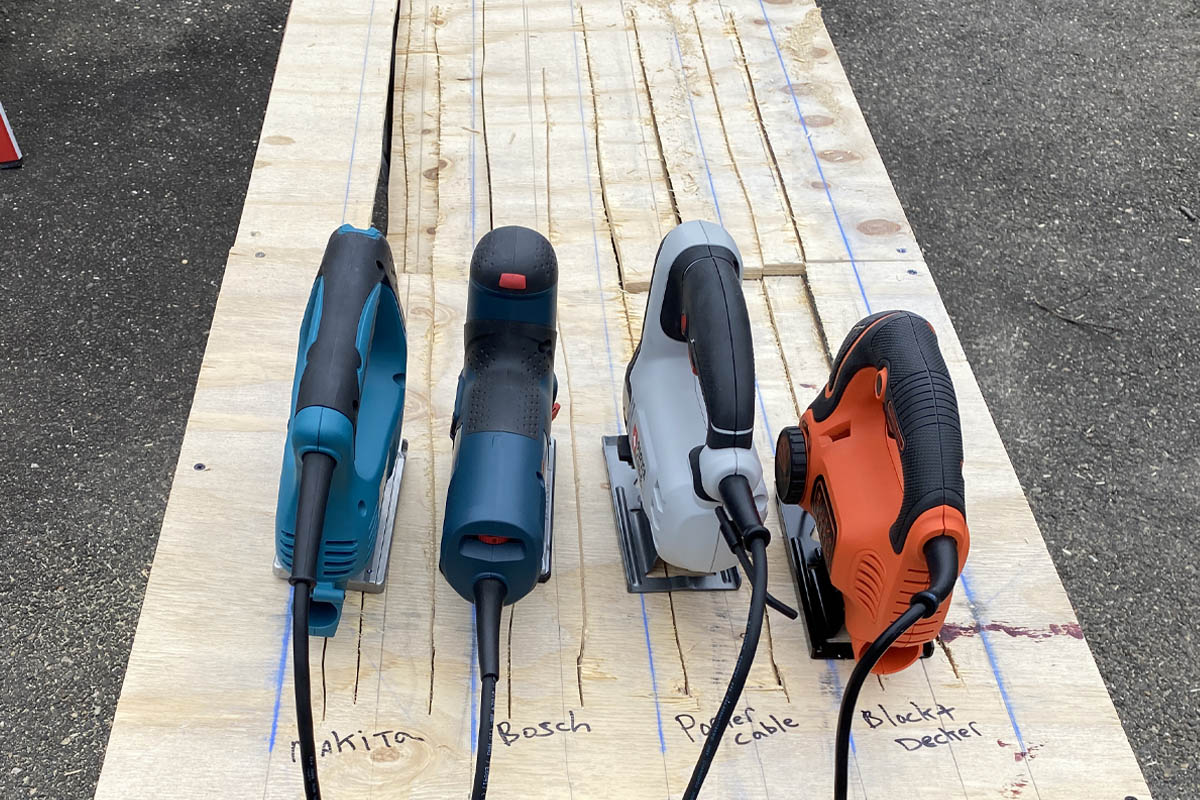
How We Tested the Best Jigsaws
Before picking our lineup of products for hands-on testing, we wanted to get additional advice from experts who use jigsaws on a daily basis. One such expert was woodworker George Matusyan, the owner and operational manager of United Windows Pro, a window installation and repair company operating throughout the Denver and Chicago areas. His recommendation is to “prioritize comfort and utility … many types of jigsaws feature onboard dust blowers that ensure visibility of your cut line—a leading attribute to neater finishes.” He also adds that “lever-action blade clamps offer an advantage too—they expedite quick, tool-free blade changes to significantly reduce downtime.”
We took Matusyan’s advice into consideration when selecting which jigsaws to test, making sure the most sought after features were included in several of our models.
In testing for the best jigsaw, we assembled each tool per the manufacturer’s directions— plugging them either into extension cords or fully charging their new batteries. With each saw fitted with a new blade, we made straight cuts with the maximum orbital setting in 2-foot lengths of 3/4-inch thick plywood.
Next, we repeated the test with the blade at the 45-degree bevel setting, swerving the saw on gentle curves as we cut. We noted how quickly the saw cut through the material, how much chip out accrued, and how well the tool’s blower (if available) functioned. In between each test, we noted the ease or difficulty of changing the blade.
Our Top Picks
To make the job of choosing the right jigsaw model easier, we tested popular jigsaws from leading tool makers, reflecting everything from pro-grade versions to entry-level priced saws that DIYers might use sparingly.
How well you use a jigsaw to cut depends heavily on how the tool feels in your hand, so it’s a good idea to visit a home center for a hands-on experience with the tools to see what grips feel the best.
Best Overall
Bosch JS572EBK Barrel-Grip Jigsaw Kit
Pros
- Heavy-duty motor is suitable for tougher projects
- Comfortable grip with one or both hands for ample versatility
- Comes with three blades for a variety of materials and project types
- Blower exceptional at clearing sawdust from the cut line
Cons
- High price, aimed at pro users
- Large 16x14x4-inch case may make storage an issue
Product Specs
- Power: 7.2-amp corded
- Speed: Up to 3,000 SPM
- Stroke type: Straight with three orbital setting
- Stroke length: 1 inch
The Bosch Barrel-Grip jigsaw is the ultimate choice for accuracy and control. This jigsaw comfortably keeps the user’s hand close to the workpiece, helping avoid the tipping that tends to occur with taller top-handle jigsaws. Also, the grip is slimmer than most barrel-style grips, for better control and improved comfort.
The saw has the highest amperage in this lineup at 7.2 amps and a speed range of 800 to 3,000 SPM; speed is regulated by a dial at the rear of the barrel. While the speed could be higher, it’s likely plenty for most jobs. This Bosch came packed with three blades, more than any other jigsaw we tested. It has a three-position setting for orbital cutting, a very convenient thumb-activated on/off switch, and a bright LED light. T-shank blade changes are easy thanks to the toolless design with blade ejection.
Granted, there are a lot of buttons and switches on this tool, from the blower setting to the orbital action, that will become more familiar with use. During our tests, this model excelled at speed, maneuverability, and minimal chip out both at 90 and 45 degrees.
Get the Bosch JS572EBK jigsaw at Amazon, Lowe’s, or The Home Depot.
Best Bang For The Buck
Ryobi 18V One+ HP Brushless Jigsaw
Pros
- A solid brushless tool that will extend runtime with standard battery
- Comfortable handle and body that sits upright between uses
- 3,400 SPM is the fastest for saws in this price range
Cons
- Chipped plywood when pushed and on max orbit setting
- Sawdust gathers at the front while cutting, decreasing blade visibility
Product Specs
- Power: 18-volt cordless
- Speed: Up to 3,400 SPM
- Stroke type: Straight with three orbital setting
- Stroke length: 1 inch
Some DIYers might consider a saw sold as a bare tool a negative, but with so many Ryobi 18 volt batteries available, many folks already have one in their tool box. Buying a bare tool lowers the cost and prevents accumulating unnecessary chargers. The Ryobi PBLJS01B is just about the most budget-friendly brushless jigsaw on the market—meaning the digital motor inside is more efficient at pulling power from the battery—providing nearly 80 percent longer runtime from the same lithium-ion power pack
The handle is roomier than the other beginner saws we tested, so it should fit a range of users. The 1-inch stroke length matches the most expensive saws in our test group, and the top end speed of 3,400 strokes per minute is pretty close to the fastest tools tested. Plus, DIYers will likely appreciate that the tool sets straight up on its battery; it needn’t rest on its side, which might cause the blade to scratch surfaces.
During the cut tests, the Ryboi felt fast and agile, but it had quite a bit of chip out at 90 degrees when set to max orbital. The sawdust also seemed to gather right at the blade, making it more challenging to see the cut line.
Get the Ryobi PBLJS01B jigsaw at The Home Depot.
Best for Beginners
Black+Decker 5-Amp Jigsaw with Curve Control
Pros
- Affordable price point compared to some other options on this list
- Setting designed for cutting curves; perfect for working on furniture
- Toolless blade changes allow for safety and ease of use
Cons
- Fan blows into the face while looking at the right side of the tool
- 3,000 SPM felt sluggish without the orbital on and when the tool is beveled at 45 degrees
- Bevel adjustment not toolless, requiring a Phillips head screwdriver
Product Specs
- Power: 5.0-amp corded
- Speed: Up to 3,000 SPM
- Stroke type: Straight with three orbital setting
- Stroke length: 3/4 inch
Budget-friendly jigsaws often come at the cost of capability and features, but that’s not the case with this model from Black & Decker. This corded model features a 5.0-amp motor (more powerful than the pricer Makita we tested) that produces up to 3,000 strokes per minute via a pressure-sensitive trigger. And with toolless blade changes, switching U-shaped blades is fast and straightforward.
This Black & Decker jigsaw features the brand’s Curve Control, a clearly marked dial that helps users to choose between straight cutting (or no orbit) and maximum orbit for working along curves. While powerful, it did splinter wood in testing because of the wide opening around the blade, and accuracy did prove to be a bit of an issue. When beveled to the max, the saw’s power felt sluggish, but that would likely improve with a better quality jigsaw blade. Those points aside, for the price, this is a good saw for beginners to learn with.
Get the Black+Decker BDEJS600C jigsaw at Amazon, Ace Hardware, or The Home Depot.
Best for Max Power
Milwaukee M18 Fuel Barrel Grip Jigsaw
Pros
- Cuts fast and with less chip out than other saws
- Powerful enough to replace a corded saw; operates at up to 3,500 SPM
- Soft start feature makes it easier to focus on accuracy
Cons
- Size may be too much for smaller hands or newcomers
- Expensive compared to other options on this list
- Bevel adjustment not toolless, though the hex wrench is located in a dedicated pocket within the shoe
Product Specs
- Power: 18-volt cordless
- Speed: Up to 3,500 SPM
- Stroke type: Straight with 3 orbital setting
- Stroke length: 1 inch
Yes, it’s big—nearly 12 inches long and more than 4.5 pounds before adding the battery—but the Milwaukee 2737B-20 is a beastly saw with brains as well as brown. The brushless saw’s power is equivalent to a 7 amp corded tool, thanks to the electronics’ engineering—so it cuts faster than every corded saw in our test group. That cranks the blade at 3,500 strokes per minute at a full 1-inch depth, meaning this saw is capable of cutting all day, through just about any material.
A helpful feature on the variable speed dial helps the operator line up the start of a cut, lowering the speed to focus on accuracy without having the tool bounce around; it then senses the load and adjusts the cutting speed automatically. During our tests, the saw cut quickly and aggressively, nearly pulling itself through the work. It also proved to have great blade visibility. Caveat: While the power switch is easily accessible by both lefties and righties, the switch requires 1-second hold to power down, which takes some getting used to.
Get the Milwaukee 2737B-20 jigsaw at The Home Depot or Ace Hardware.
Best Ergonomic Handle
DeWalt 20V MAX XR Cordless Jigsaw
Pros
- Excellent power and cut speed for fast and effective use
- Comfortable handle design with intuitive buttons and switches; ideal choice for new users
- The biggest and easiest-to-use blade change clamp on this list
- Good dust blower to keep cutting line clear and dust particles away from the user’s eyes and face
Cons
- Slightly slower stroke rate than similar-priced saws
- Not vacuum compatible; may spread dust and debris all over the workspace
- Some bevel marks are hard to read
- No lock-on button integrated into the design
Product Specs
- Power: 20-volt cordless
- Speed: Up to 3,200 SPM
- Stroke type: Straight with three orbital setting
- Stroke length: 1 inch
For those who already own another of DeWalt’s 20-volt tools, this jigsaw is a very good addition, especially when purchased as a bare tool. Of all the saws we tested, the grip on this one fit best because it’s narrow and felt almost like a drill/driver—very comfortable. The max speed of 3,200 strokes per minute was fast enough to blast through the wood when set to the max orbital setting, though we did experience some splintering in tests. That somewhat lower speed and vibration, along with the comfy grip, helps stave off hand fatigue. We liked the excellent blade visibility, especially when cutting at 45 degrees, and the blower feature that kept sawdust away from the blade. The tool-less bevel adjustment locks in securely.
On the downside, the DeWalt is not vacuum-compatible, and it does not have a lock-on button, which would act like a cruise control during longer cuts. Also, while the shoe has detents that lock in at 0, 15, 30, and 45 degrees, only the 45-degree mark is clearly identified with numbers.
Get the DeWalt DCS334B jigsaw at Amazon, Lowe’s, or The Home Depot.
Best Lightweight Saw
Makita 4329K Top Handle Jigsaw
Pros
- Slide-down dust shield prevents dust and debris from getting into the user’s eyes and face
- The lightest corded saw we tested; suitable for those with wrist, shoulder, or back issues
- Through-the-body vacuum port keeps dust and debris away from the workspace
Cons
- Wrench required to attach blade; may be tricky for newcomers
- Fewest orbital settings of saws tested
- Slightly short stroke length compared to other options on the market
Product Specs
- Power: 3.9-amp corded
- Speed: Up to 3,100 SPM
- Stroke type: Straight with two orbital settings
- Stroke length: 11/16 inch
Not everyone needs the burliest, heaviest-duty jigsaw on the market. At just over 4 pounds, this saw is easy to work with and the 3.9-amp motor produces up to 3,100 strokes per minute, with speed adjustments coming via the variable speed trigger. It also features a through-the-body vacuum port to improve dust collection, making it easier to see the blade while cutting.
Despite the Makita name familiar to pro users, the 4329K Jigsaw is more of a beginner’s model. The slide-down dust cover features a see-through design that minimizes chips and protects the user’s hands, while the counterbalanced design reduces vibration to minimize fatigue and improve control. Cutting at 90 degrees was fast and smooth, even when the orbital was switched to the max, and the same was true for cutting at 45 degrees. Our only peeves: This saw requires a wrench to attach the blade, which slows down blade changes, and its slightly shorter stroke length means it isn’t ideal for thicker material.
Get the Makita 4329K jigsaw at Amazon, The Home Depot, or Walmart.
Best for Fast Cutting
Porter-Cable 6-Amp Orbital Jigsaw
Pros
- Built-in trigger lock; acts as a cruise control while the jigsaw is in use
- Toolless blade changes for safety and ease of use
- Comfortable rubber grip makes it easy to guide with both hands
Cons
- Relatively bare-bones device; does not come with a lot of bells and whistles
- Bevel adjustment requires a tool, which is stored on the power cord
- Stroke length of less than 1-inch is disappointing, considering the power
Product Specs
- Power: 6.0-amp
- Speed: Up to 3,200 SPM
- Stroke type: Straight with three orbital setting
- Stroke length: 13/16 inch
Orbital strokes allow jigsaws to work faster and more aggressively, and like a lot of the better saws, this Porter-Cable Orbital jigsaw offers four settings. Better yet, it doesn’t have a premium price tag. Beyond the orbital settings, this saw features a heavy-duty 6-amp motor for hard work and prolonged use. For those long cuts, there’s a lock-on switch to hold the trigger in place and act as a cruise control.
The overmolded rubberized handle is comfortable, while the large rubberized section on the front of the saw makes for a convenient place for the second hand to guide the saw along cut lines. We liked the variable speed dial mounted on the trigger but, while performance proved similar to the Makita, the Porter-Cable is nearly a full pound heavier and a bit bulker. Also, this jigsaw doesn’t come with a work light, dust control, or any additional features—it’s a good saw, though fairly bare bones.
Get the Porter-Cable PCE345 jigsaw at Amazon, Lowe’s, or The Home Depot.
Jump to Our Top Picks
What to Consider When Choosing a Jigsaw
Today’s jigsaws tend to be far more feature-rich than the models of the past, offering varying cutting speeds, different levels when it comes to aggressive cutting, amperages, and power supply options. Some options make sense, while others might be an unnecessary bell or whistle a DIY likely doesn’t need.
Type
Jigsaw puzzled? No surprise! Here’s the need-to-know info about how different models stack up.
Straight-Reciprocating
Older models and newer low-end options are typically straight-reciprocating jigsaws. This means the blade simply travels up and down with no variance in its path. Though these jigsaws cut slowly, they’re able to make very tight turns and create curves, unlike a table or a circular saw. All modern jigsaws have a zero orbital option and all the versions we tested have selectable switches to increase the orbit —or aggressiveness—of the cut.
Orbital-Reciprocating
These jigsaws have a slightly forward motion to their blade stroke. The blade tilts forward on the upstroke, clearing wood more quickly than a straight-reciprocating jigsaw. To activate orbital-reciprocation, the user typically flips a switch on the side of the saw into one of (usually) four positions. These saws cut faster but with less accuracy and maneuverability than straight-reciprocating models. There will also be more tear-out (splintered wood that chips up along the cutline) on the top of the wood.
Top Handle
Traditional jigsaws have a tall, large handle shaped like the letter D with a basic finger trigger inside the hand loop to operate the saw. This grip is easy to wrap a hand around, but the height increases lateral leverage, which can tip the saw and lead to less accuracy. While handle type is a matter of preference, those with smaller hands will usually have an easier time controlling top-handle saws.
Barrel Grip
A newer form, barrel-grip jigsaws allow users to keep their hand lower to the material they’re working on. This can increase control, minimizing the tendency to tip the saw and skew the blade’s path. These models usually have thumb switches instead of finger triggers. Often DIYers and pros who do a lot of “under the table” cutting, where the blade faces up while following a line, will find these tasks easier using a barrel grip.
Cordless vs. Corded
Most tool manufacturers offer both versions of this tool, and some even offer cordless versions of different voltages (i.e., 18- and 12-volt). Typically, a corded jigsaw costs quite a bit less than a cordless version. Most makers offer cordless saws both as kits, paired with a battery and a charger, and as a bare tool without a battery or charger. The latter makes it easier to weave the tool into an existing cordless tool kit, using the same batteries and charger that’s already owned.
Cutting extremely dense woods like oak or walnut can chew through battery life pretty quickly, so woodworkers should check into corded options. For site work like decks and pergolas, battery-powered models are the way to go.
Amperage and Cutting Speed
Amp ratings on power tools refer to the amount of power they can draw without compromising the motor or internal components. Generally, the higher the amperage, the more heavy-duty the tool. Most modern jigsaws range between 5.0 and 7.0 amps.
All jigsaws have varied cutting speeds, operated by either a pressure-sensitive trigger or an adjustable dial. These power tools also have adjustable speed ranges, starting at around 500 strokes per minute (SPM) and up to 3,000 to 4,000 strokes per minute at the top end.
Cabinetmakers, woodworkers, and metalworkers will most likely enjoy dialed speed control that provides consistent results. For the multipurpose DIY workshop, a do-it-all jigsaw with a pressure-sensitive trigger might be a better choice, as it can easily bounce from job to job without much fuss.
Blade Type and Material
There are two types of jigsaw blade options: T-shank and U-shank. Many of the best jigsaws use T-shank blades, which lock in easily (usually without the use of tools) and stay secure during tight curves and decorative cuts. U-shank-style saws sometimes require tools for blade changes, making them far less popular since the invention of T-shank blades.
Also, there are three different materials used to make jigsaw blades:
- High carbon steel blades are inexpensive and they’re fine for most construction work. These blades are flexible but dull easily.
- Manufacturers make bi-metal blades from carbon steel with high-speed tool steel for the teeth. They’re flexible, but the blades stay sharper longer.
- The most durable jigsaw blades utilize tungsten carbide. These blades are expensive but highly heat resistant.
Safety
In the grand scheme of power tools, jigsaws are relatively low risk for injury, but there are some built-in features that make them safer to handle. For instance, many jigsaws have onboard LED lights that illuminate the cutline and ensure the user can see where they’re cutting—one of the most critical aspects of power tool safety.
There are also safeties that the user must depress before squeezing the trigger, preventing accidental activation from occurring. These buttons are typically mounted on the handle where the user can reach them with a thumb, and a quick press allows the user to activate the saw.
Additional Features
Beyond amperage, speed, and safety features, there are additional features that can make a jigsaw more functional, convenient, and/or easier to use.
- Dust management: Jigsaws don’t kick up nearly as much sawdust as a table saw, miter saw, circular saw, or other types of saws; instead of turning wood to dust, these jigsaws take chunks out of the material. Still, these chunks can land on the cutline, challenging visibility, so some models include dust blowers that fan small chunks off the cutline. Although jigsaws create minimal mess, for a sawdust-free work space, look for a model that attaches to a shop vac.
- Blade change system: Quick-release blade retention systems make switching blades a breeze. These systems have spring-loaded chucks that clamp down on the blade shank, holding it firmly in place until the user changes the blade. This is a huge improvement over older systems, which required hex keys to remove the blade.
- Size and weight: Wielding a jigsaw isn’t typically strenuous work, but size and weight might be a consideration. Most jigsaws weigh well under 10 pounds, but some lighter models weigh just 5 pounds or so. Also, some jigsaws feature barrel grips, which make them more compact than top-handle jigsaw models.
- Ergonomics: Some jigsaws feature ergonomic designs, such as rubber overmolded handles to reduce vibration and improve grip. Also, thumb-activated speed adjustments and multiple trigger positions (such as one on each side of the saw) allow for comfortable hand positions regardless of handedness.
FAQs
Even with ample background on the best jigsaws, some additional questions might be popping up. This section, a collection of some of the most frequently asked questions about jigsaws, aims to answer those queries, so check for the info you need below.
Q. What is a jigsaw best used for?
Jigsaws excel at making circular or rounded cuts for decorative woodwork and crafts. However, they’re also handy for making square cuts where a circular saw might not work, such as toe-kicks for cabinets and stringers for stairs.
Q. Can you cut straight with a jigsaw?
You can, but straight cuts are not as easy as they are with a circular saw. The skinny blade is more likely to curve, but clamping a straightedge to the workpiece will help allow the user to cut straight.
Q. What is the difference between a jigsaw and a reciprocating saw?
Both jigsaws and reciprocating saws have reciprocating motions, but they are different types of saws. Jigsaws use small, thin blades with short strokes, while reciprocating saws have larger, thicker blades with longer strokes. Reciprocating saws are heavier duty, so they’re often used for demolition, cutting pipes, and other tough materials.
Q. How do I choose a jigsaw?
Choosing a jigsaw comes down to a few factors:
- Compatibility with your existing battery system
- Built-in features like LED lights, dust blowers, and orbital cutting
- Budgetary constraints
Meet the Tester
Sal Vaglica has covered tools and DIY projects since 2006 for such sites as Better Homes & Gardens, Wired, This Old House, and Fine Homebuilding. A former hardwood flooring contractor, he prefers to test tools hands-on whenever possible by replicating scenarios readers might face at their own homes.
